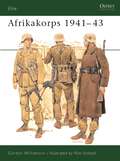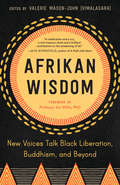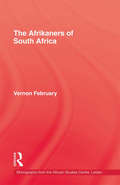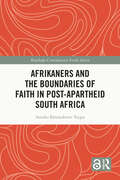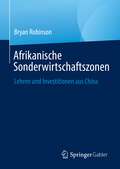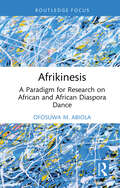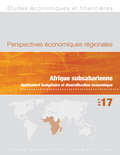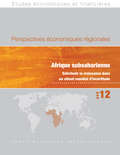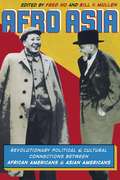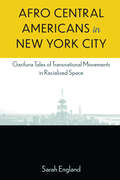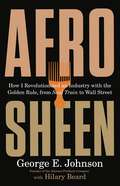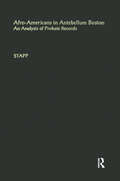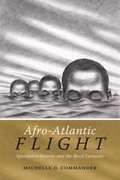- Table View
- List View
Afrikakorps 1941-43
by Ronald Volstad Gordon WilliamsonOsprey's study of the German Afrikakorps of World War II (1939-1945). The campaign in North Africa between September 1940 and May 1943 holds not only an enduring fascination for postwar generations; but also a perhaps unique degree of nostalgia for some surviving participants. The campaign was no less costly in terms of human lives and material than many others; but regret at the cost is accompanied by positive memories in the minds of many veterans. This is not to suggest that the dead have been forgotten; but an almost mystical bond nevertheless exists, even between former enemies, amongst veterans of the desert campaign. Gordon Williamson examines the history, organisation and uniforms of Rommel's Afrikakorps.
Afrikakorps Soldier 1941-43
by Pier Battistelli Raffaele RuggeriThis book explores the experiences of the German Afrika Korps soldier during the North Africa campaign of World War II (1939-1945), from the Korps' arrival in the North African theater in February 1941 to its eventual surrender in Tunisia in May 1943, with a particular focus on the intense period of warfare in the Western Desert between 1941 and 1942. Under the leadership of one of the war's most famous commanders, Erwin Rommel, the Afrika Korps grew to include a broad range of armor, infantry, artillery, anti-tank, engineer, communication, supply, medical and service elements. The soldiers of the Afrika Korps considered themselves as part of an elite, a highly select group that had no equal, not only in the German Army, but in the rest of the world.
Afrikan Wisdom: New Voices Talk Black Liberation, Buddhism, and Beyond
by Valerie Mason-JohnA spiritual, political, and interdisciplinary anthology of wisdom stories from Black liberation leaders and teachers.Afrikan Wisdom represents an intersectional, cross-pollinated exploration of Black life--past, present, and future. Award-winning author and editor Valerie Mason-John (Vimalasara)'s collection of 34 essays--written by an eclectic and inspirational group of Black thought leaders and teachers--reflects on the unique and multilayered experience of being Black in the world today. This anthology instills in readers the knowledge, awareness, validation, and spiritual tools necessary to nurture both individual and collective liberation. It is both an inspiration and a motivation for Black readers, as well as anyone else interested in reading about emerging spiritual voices. Topics include: • African and Afro-Diasporan cultures, histories, spiritualities, art, music, and literature • Black radical traditions of liberation and consciousness • Anticolonialism and antislavery • Buddhist philosophy • Social and environmental justice • The prison industrial complex and mass incarceration • (Kemetic) yoga, healing, and mindfulness • Intersections with Indigenous cultures • Addiction and recovery • Transgenerational trauma
Afrikaners Of South Africa
by FebruaryFirst Published in 1991. Routledge is an imprint of Taylor & Francis, an informa company.
Afrikaners and the Boundaries of Faith in Post-Apartheid South Africa (Routledge Contemporary South Africa)
by Annika Björnsdotter TeppoThis book examines the shifting moral and spiritual lives of white Afrikaners in South Africa after apartheid. The end of South Africa’s apartheid system of racial and spatial segregation sparked wide-reaching social change as social, cultural, spatial and racial boundaries were transgressed and transformed. This book investigates how Afrikaners have mediated the country’s shifting boundaries within the realm of religion. For instance, one in every three Afrikaners used these new freedoms to leave the traditional Dutch Reformed Church (NGK), often for an entirely new religious affiliation within the Pentecostal or Charismatic churches, or New Religious Movements such as Wiccan neopaganism. Based on long-term ethnographic fieldwork in the Western Cape area, the book investigates what spiritual life after racial totalitarianism means for the members of the ethnic group that constructed and maintained that very totalitarianism. Ultimately, the book asks how these new Afrikaner religious practices contribute to social solidarity and integration in a persistently segregated society, and what they can tell us about racial relations in the country today. This book will be of interest to scholars of religious studies, social and cultural anthropology and African studies.
Afrikanische Sonderwirtschaftszonen: Lehren und Investitionen aus China
by Bryan RobinsonDieses Buch bewertet afrikanische Sonderwirtschaftszonen aus einer Perspektive der Lehren und Erfahrungen, die China mit solchen Zonen gemacht hat, deren Auswirkungen auf die chinesische Politik und auf Investitionen.Unter Verwendung von Fallstudien über als erfolgreich wahrgenommene Sonderwirtschaftszonen in China, wird das chinesische Modell dieser Zonen als Bewertungs- und Benchmarking-Instrument vorgeschlagen, mit dem afrikanische Sonderwirtschaftszonen verglichen werden.Anhand mehrerer Fallstudien zu afrikanischen Sonderwirtschaftszonen wird im Buch die Wettbewerbsfähigkeit dieser mit besonderem Augenmerk auf die Anwerbung chinesischer Investoren für diese Zonen untersucht. Die wirtschaftlichen, sozialen und ökologischen Auswirkungen dieser Zonen werden bewertet. Die Bemühungen afrikanischer Staaten erfolgreiche Sonderwirtschaftszonen zu ermöglichen oder dies nicht zu tun, werden kritisch analysiert.Schließlich werden die Sonderwirtschaftszonen in Afrika mit dem chinesischen Modell verglichen, und es wird ein afrikanisches Modell für Sonderwirtschaftszonen vorgeschlagen. Es werden Empfehlungen an die Führung der afrikanischen Staaten sowie an chinesische Entscheidungsträger und Investoren gegeben, wie diese Zonen verbessert werden können, um die Wettbewerbsfähigkeit zu steigern und die Ziele der nachhaltigen Entwicklung der Zonen zu erreichen. Bryan Robinson ist wissenschaftlicher Mitarbeiter und Senior Lecturer an der Nelson Mandela University Business School, Port Elizabeth, Südafrika.Dieses Buch stellt die Übersetzung einer englischsprachigen Originalausgabedar. Die Übersetzung wurde mit Hilfe von künstlicher Intelligenz erstellt (maschinelle Übersetzung mit DeepL.com). Eine anschließende manuelle Überarbeitung erfolgte vor allem nach inhaltlichen Gesichtspunkten, so dass sich das Buch stilistisch von einer herkömmlichen Übersetzung abweicht.
Afrikinesis: A Paradigm for Research on African and African Diaspora Dance (Routledge Advances in Theatre & Performance Studies)
by Ofosuwa M AbiolaThis book provides scholars and non-specialists alike with a roadmap for effectively conducting culturally aware, historically relevant research on African dance and on any dance style that contains African elements. This book explains why Western research paradigms are inadequate for research on Africana dance. It exposes the value of utilizing an appropriate research paradigm that offers researchers a broader perspective and a transparent, unfettered process for analysis in under-researched topics such as African and African diaspora dance styles. Researchers are introduced to the African dance aesthetic, characteristically African body movements, definitions of steps, understandings within African culture, and a host of other jewels that facilitate a deeper grasp on the subject and refine the quality of the scholar’s research, its findings, and its proficiency. This book will be of great interest to scholars of African dance studies.
Afrique subsaharienne Ajustement budgétaire et diversification économique
by International Monetary FundA report from the International Monetary Fund.
Afrique subsaharienne: Entretenir la croissance dans un climat mondial d'incertitude, Avril 12
by International Monetary FundA report from the International Monetary Fund.
Afro Asia: Revolutionary Political and Cultural Connetions Between African Americans and Asian Americans
by Fred Ho Bill V. MullenWith contributions from activists, artists, and scholars, Afro Asia is a groundbreaking collection of writing on the historical alliances, cultural connections, and shared political strategies linking African Americans and Asian Americans. Bringing together autobiography, poetry, scholarly criticism, and other genres, this volume represents an activist vanguard in the cultural struggle against oppression. Afro Asia opens with analyses of historical connections between people of African and of Asian descent. An account of nineteenth-century Chinese laborers who fought against slavery and colonialism in Cuba appears alongside an exploration of African Americans' reactions to and experiences of the Korean "conflict. " Contributors examine the fertile period of Afro-Asian exchange that began around the time of the 1955 Bandung Conference, the first meeting of leaders from Asian and African nations in the postcolonial era. One assesses the relationship of two important 1960s Asian American activists to Malcolm X and the Black Panthers. Mao Ze Dong's 1963 and 1968 statements in support of black liberation are juxtaposed with an overview of the influence of Maoism on African American leftists. Turning to the arts, Ishmael Reed provides a brief account of how he met and helped several Asian American writers. A Vietnamese American spoken-word artist describes the impact of black hip-hop culture on working-class urban Asian American youth. Fred Ho interviews Bill Cole, an African American jazz musician who plays Asian double-reed instruments. This pioneering collection closes with an array of creative writing, including poetry, memoir, and a dialogue about identity and friendship that two writers, one Japanese American and the other African American, have performed around the United States. Contributors: Betsy Esch, Diane C. Fujino, royal hartigan, Kim Hewitt, Cheryl Higashida, Fred Ho, Everett Hoagland, Robin D. G. Kelley, Bill V. Mullen, David Mura, Ishle Park, Alexs Pate, Thien-bao Thuc Phi, Ishmael Reed, Kalamu Ya Salaam, Maya Almachar Santos, JoYin C. Shih, Ron Wheeler, Daniel Widener, Lisa Yun
Afro Central Americans in New York City: Garifuna Tales of Transnational Movements in Racialized Space
by Sarah EnglandDescended from African maroons and the Island Carib on colonial St. Vincent, and later exiled to Honduras, the Garifuna way of life combines elements of African, Island Carib, and colonial European culture. Beginning in the 1940s, this cultural matrix became even more complex as Garifuna began migrating to the United States, forming communities in the cities of New York, New Orleans, and Los Angeles. Moving between a village on the Caribbean coast of Honduras and the New York City neighborhoods of the South Bronx and Harlem, England traces the daily lives, experiences, and grassroots organizing of the Garifuna.Concentrating on how family life, community life, and grassroots activism are carried out in two countries simultaneously as Garifuna move back and forth, England also examines the relationship between the Garifuna and Honduran national society and discusses much of the recent social activism organized to protect Garifuna coastal villages from being expropriated by the tourism and agro-export industries.Based on two years of fieldwork in Honduras and New York, her study examines not only how this transnational system works but also the impact that the complex racial and ethnic identity of the Garifuna have on the surrounding societies. As a people who can claim to be Black, Indigenous, and Latino, the Garifuna have a complex relationship not only with U.S. and Honduran societies but also with the international community of nongovernmental organizations that advocate for the rights of Indigenous peoples and blacks.Publication of the paperback edition made possible by a Sustaining the Humanities through the American Rescue Plan grant from the National Endowment for the Humanities.
Afro Sheen: How I Revolutionized an Industry with the Golden Rule, from Soul Train to Wall Street
by George E JohnsonThe inspiring and resilient story of George E. Johnson, creator of the iconic Afro Sheen and the first Black-owned company to be traded on Wall Street You might already be familiar with Afro Sheen and Ultra Sheen, but have you heard of the man behind the company that produced these products? In Afro Sheen, George Ellis Johnson, the acclaimed self-made businessman, reveals his inspiring and captivating rise from humble beginnings to the top of the haircare industry. At just twenty-seven years old, Johnson created the Johnson Products Company. JPC was the first Black-owned company to trade on a major stock exchange, became the financial sponsor of Soul Train, and was once considered the largest Black-owned manufacturing company in the world. At the height of its success, JPC was worth $37 million (over $225 million today). In this coming-of-age story, Johnson uses the life skills and strong character built from working odd jobs as a teenager and practicing the Golden Rule to create a business that both nurtures and advances the Black community. Without a formal education, he filled a gap in the Black haircare industry and created a high-quality formula for straightening hair and the iconic Ultra Sheen and Afro Sheen products that supported Black people in expressing their authentic beauty. For decades, Johnson has been an inspiration to Black entrepreneurs, setting an example of Black wealth and providing a safe space for Black people to work. Afro Sheen is a timely, impassioned look at both an industry and cultural moment. Johnson&’s impact is finally on full display, as he brilliantly highlights how having perseverance and a daring vision can create both change and a lasting legacy.
Afro-Americans in Antebellum Boston: An Analysis of Probate Records (Studies in African American History and Culture)
by Carol Buchalter StappFirst published in 1993. Routledge is an imprint of Taylor & Francis, an informa company.
Afro-Atlantic Flight: Speculative Returns and the Black Fantastic
by Michelle D. CommanderIn Afro-Atlantic Flight Michelle D. Commander traces how post-civil rights Black American artists, intellectuals, and travelers envision literal and figurative flight back to Africa as a means by which to heal the dispossession caused by the slave trade. Through ethnographic, historical, literary, and filmic analyses, Commander shows the ways that cultural producers such as Octavia Butler, Thomas Allen Harris, and Saidiya Hartman engage with speculative thought about slavery, the spiritual realm, and Africa, thereby structuring the imaginary that propels future return flights. She goes on to examine Black Americans’ cultural heritage tourism in and migration to Ghana; Bahia, Brazil; and various sites of slavery in the US South to interrogate the ways that a cadre of actors produces “Africa” and contests master narratives. Compellingly, these material flights do not always satisfy Black Americans’ individualistic desires for homecoming and liberation, leading Commander to focus on the revolutionary possibilities inherent in psychic speculative returns and to argue for the development of a Pan-Africanist stance that works to more effectively address the contemporary resonances of slavery that exist across the Afro-Atlantic.

